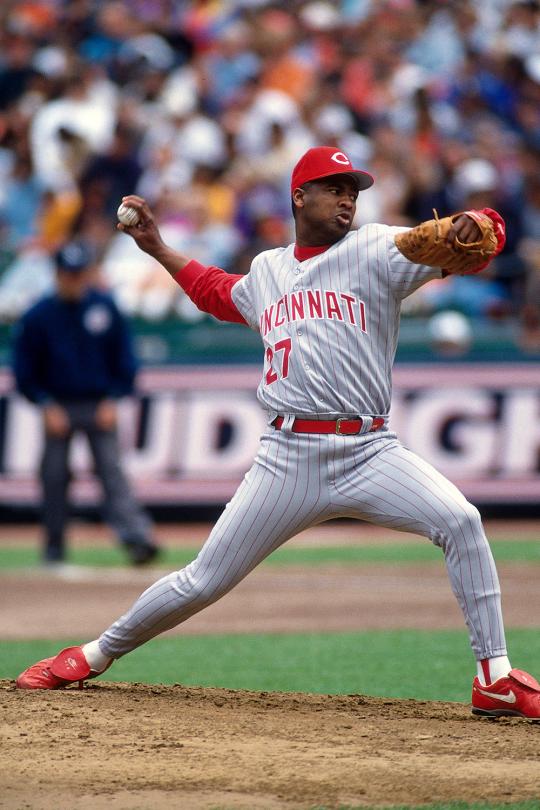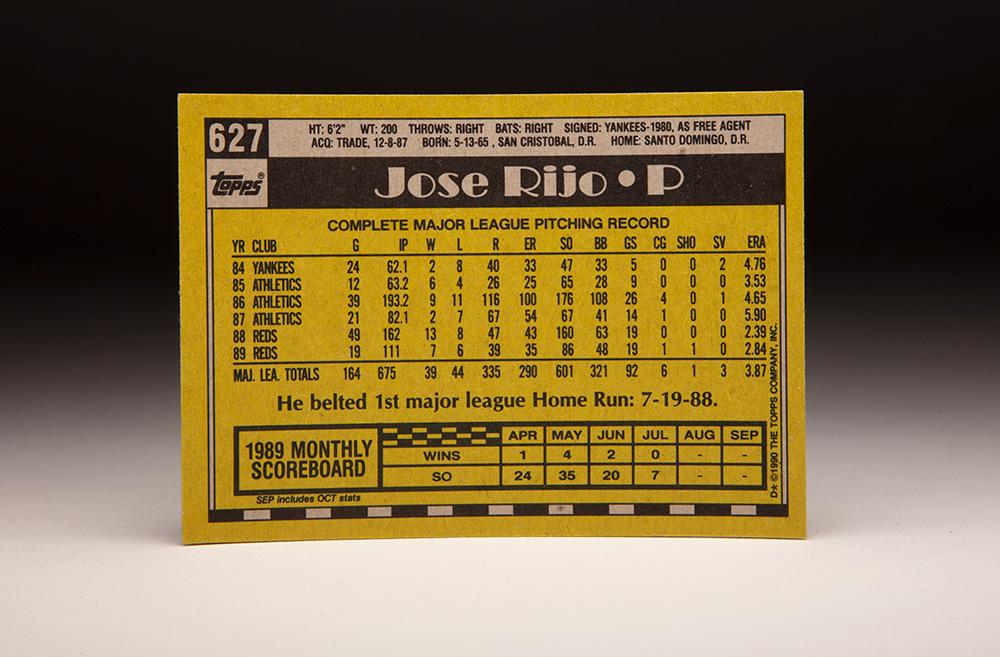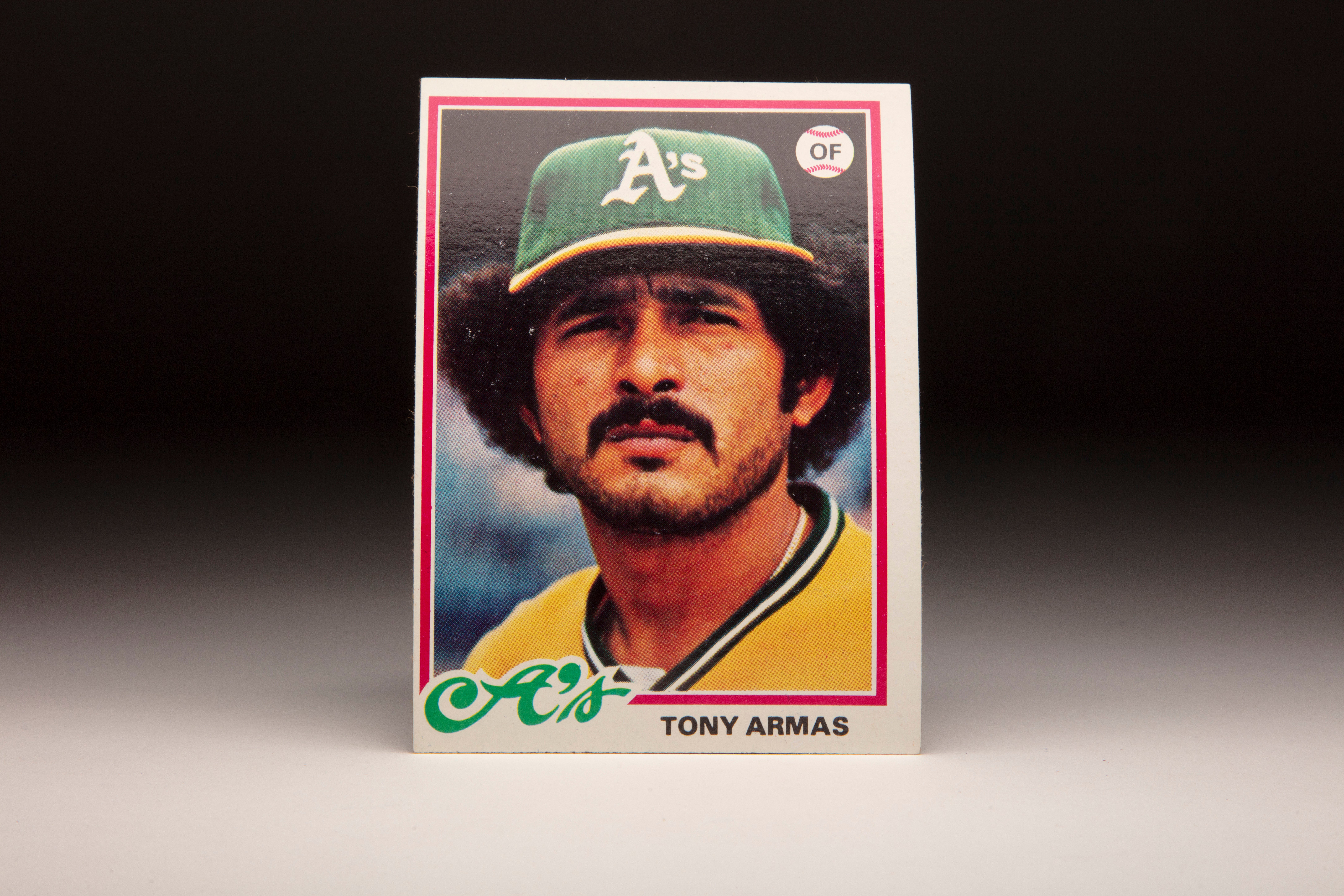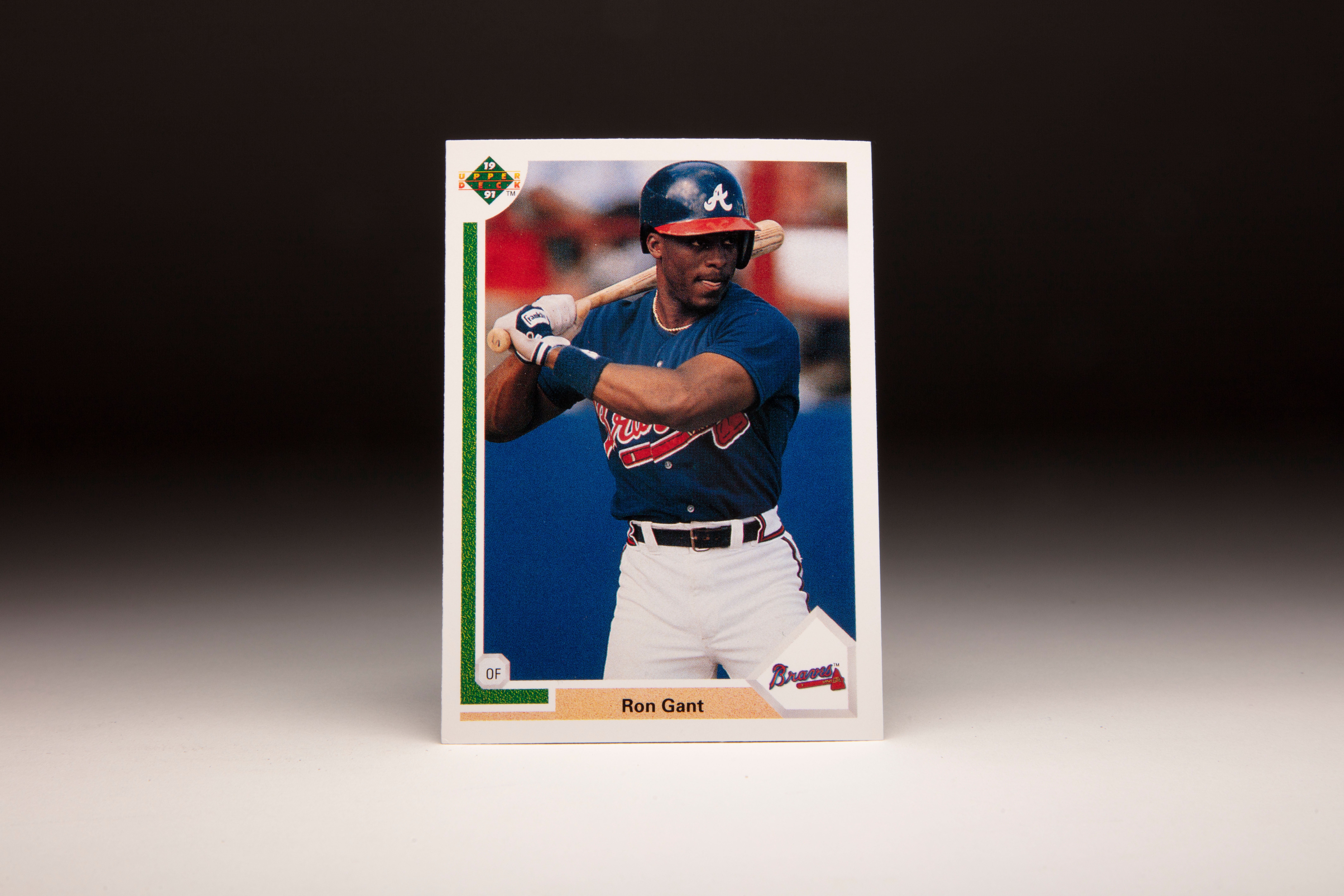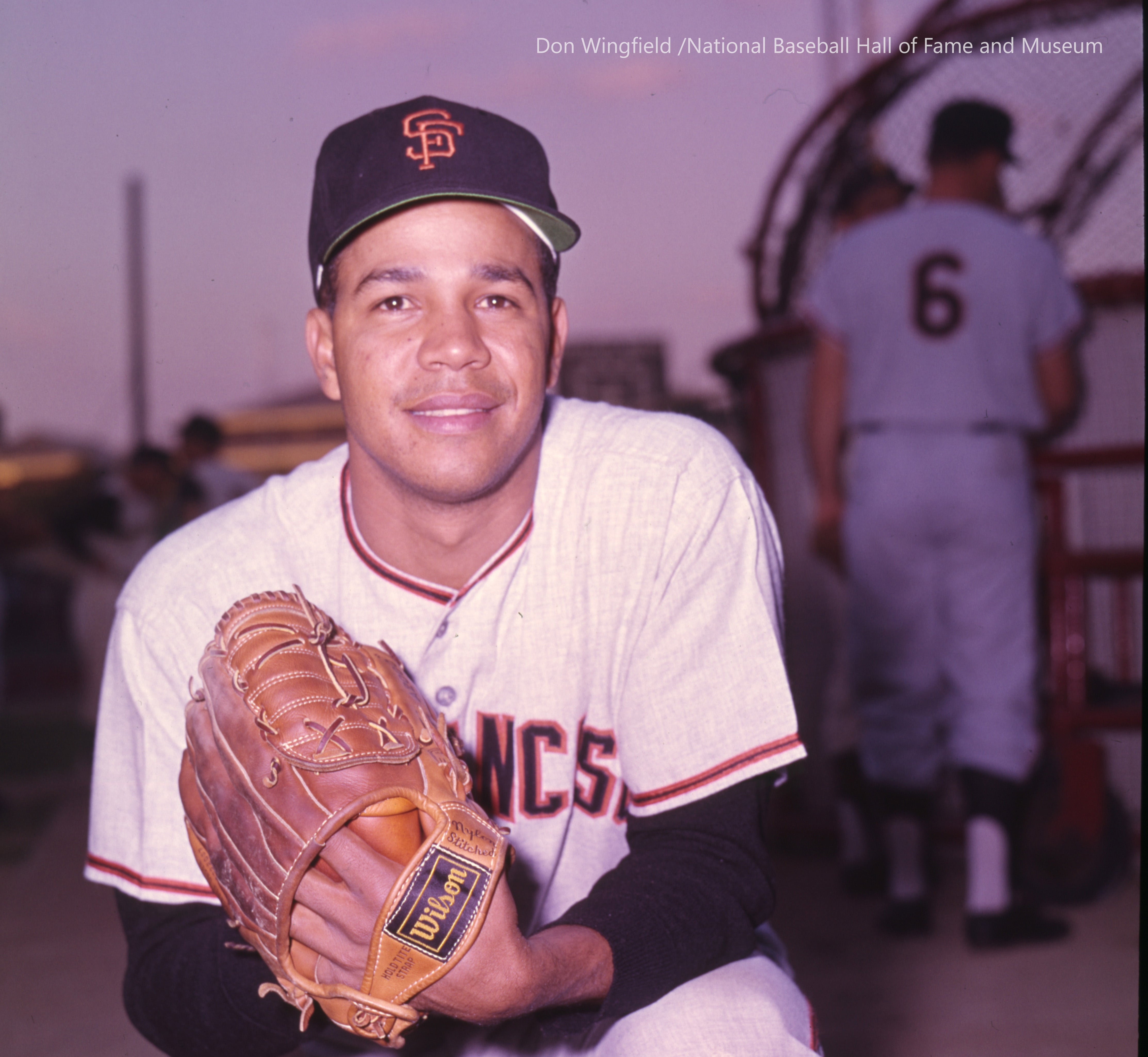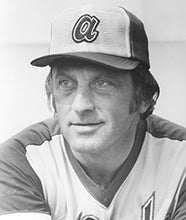- Home
- Our Stories
- #CardCorner: 1990 Topps José Rijo
#CardCorner: 1990 Topps José Rijo
In the spring of 1984, Dwight Gooden set the baseball world aflame with a dominant Spring Training performance that won the 19-year-old right-hander a spot in the Mets’ starting rotation.
Not to be outdone by his crosstown rivals, Yankees owner George Steinbrenner countered with his own teenage pitching phenom – an 18-year-old right-hander from the Dominican Republic named José Rijo.
And while Rijo experienced nowhere near the immediate success Gooden did, he eventually evolved into a World Series MVP with 116 victories to his credit.
Born May 13, 1965 – the same day that his future Yankees teammate Phil Niekro won his first big league game – Rijo grew up in the Dominican Republic city of San Cristóbal, located on the southern shores of Hispaniola. One of 13 children, Rijo was signed by the Yankees for a reported $3,000 before he even turned 16 and was pitching with the Yankees’ Gulf Coast League team by 1981 after debuting in the Dominican League against future big leaguers the year before. In 1982 in Paintsville, Ky., Rijo went 8-4 with a 2.50 ERA in the Appalachian League.
“I signed because I hated school and my family needed the money,” Rijo said of his original contract with the Yankees. “I knew leaving school was a big gamble. If I didn’t succeed in baseball, I didn’t know what I would do.”
Be A Part of Something Greater
There are a few ways our supporters stay involved, from membership and mission support to golf and donor experiences. The greatest moments in baseball history can’t be preserved without your help. Join us today.
He began the 1983 season with Fort Lauderdale of the Florida State League and overwhelmed Class A batters to the tune of a 15-5 record and a 1.68 ERA in 15 complete games over 21 starts. His 97-mile per hour fastball combined with a hard slider stamped him as big league material.
“The first two years, it was really a bad experience,” Rijo told the Fort Lauderdale News. “I was crying every day. I was calling home every day to talk with my parents and friends.”
But success on the diamond gave Rijo confidence, and the Yankees promoted him to Double-A Nashville toward the end of the 1983 campaign.
By Spring Training of 1984, Rijo was the talk of Yankees camp.
“It’s tough to believe he’s only 18, isn’t it?” future Hall of Famer Andre Dawson told the Fort Lauderdale News. “I was surprised at how fast the ball got to the plate on me. I don’t know how long he can last as a starter, but for a couple innings, he can help the Yankees.”
Rijo won the team’s James P. Dawson Award given to the best rookie in camp. The Yankees, who had championship aspirations in 1984, brought Rijo north with the rest of the Opening Day roster.
“I know I can make it right now,” Rijo told the Fort Lauderdale News. “I believe in my arm.”
Rijo made his big league debut on April 5 with 5.1 innings of one-run relief against the Royals in a 14-5 Yankees loss. Gooden debuted two days later for the Mets and would go about crafting one of the most dominant rookie seasons a pitcher has ever fashioned.
Rijo, meanwhile, notched his first save with three innings of hitless work against the Indians on April 18, giving him 12.1 innings of work with only one run allowed. But three rough outings followed before the Yankees began transitioning him into the rotation in May.
By the first week of July, Rijo had lost his rotation spot and was sporting a 2-8 record and 4.76 ERA.
“I know he has the arm, and I know he has the head,” said Yankees coach Clyde King during Rijo’s magical Spring Training of 1984. “And he has shown us he has the heart.”
On July 9, the Yankees optioned Rijo – still the youngest player in the big leagues at that point – to Triple-A Columbus. He finished the year with a 3-3 record and a 4.41 ERA for the Clippers.
But unlike many of his teammates, Rijo did not go back and forth to New York on the Columbus shuttle. On Dec. 5, 1984, the Yankees pulled off a blockbuster deal that brought Rickey Henderson (and Bert Bradley) to New York in exchange for Tim Birtsas, Jay Howell, Stan Javier, Eric Plunk and Rijo – the primary target for the A’s in the deal.
Ticketed to start the season with Triple-A Tacoma, Rijo looked refreshed in Spring Training and had the A’s thinking that he might make the Opening Day roster.
“There was a lot of concern whether José had lost his confidence after what happened to him last season with the Yankees,” Oakland manager Jackie Moore told the San Francisco Examiner. “But it’s obvious his confidence is back.”
But the A’s resisted the temptation to rush Rijo and sent him to Triple-A, where he was 7-10 with a 2.90 ERA and 179 strikeouts (tops in the Pacific Coast League at the time he was recalled) when he was brought back to Oakland in August. In 12 appearances – including nine starts – with the A’s, Rijo went 6-4 with a 3.53 ERA.
Rijo opened the 1986 season in the Athletics’ rotation and flashed his potential by striking out 16 Mariners batters on April 19, setting a new franchise record for a non-extra inning performance. He struck out 14 five days later against Seattle but was returned to the bullpen after an eight-walk outing against the Orioles on May 28.
But after Moore was fired on June 26, new manager Tony La Russa put Rijo back in the rotation. He posted two more double-digit strikeout games down the stretch, finishing the year with a 9-11 record with a 4.65 ERA and 176 strikeouts over 193.2 innings.
With expectations high in 1987, Rijo struggled in April – losing his spot in the rotation after working to a 5.85 ERA in his first five appearances. The A’s sent Rijo to Triple-A in May, and he bounced back and forth all year long, totaling a 2-7 record in Oakland and a 2-4 mark with Tacoma.
He married Rosie Marichal – the daughter of Hall of Famer Juan Marichal – in September of 1987.
“I owe a lot to Juan,” said Rijo, who was tutored by Marichal while he was the Athletics’ Latin American scouting co-coordinator. “He taught me how to have patience, how to concentrate, how to prepare yourself before a game.”
On Dec. 8, 1987, the A’s – looking for the final pieces for a team poised to make the postseason – sent Rijo and Birtsas to the Reds in exchange for Dave Parker. It would turn out to be a trade that would win Cincinnati a World Series title.
Reds manager Pete Rose installed Rijo as a set-up man for closer John Franco, and Rijo pitched well out of the bullpen with a 6-1 record and 2.25 ERA through June 4. But with injuries besetting the Reds’ rotation, Rose moved Rijo into a starting role and went with a four-man rotation.
Following a 12-strikeout performance against Montreal on July 23, Rijo was 11-5 with a 2.44 ERA. But he began to experience elbow pain and lasted only two innings against the Braves on Aug. 14, tossing Rose’s chair down the dugout steps at Riverfront Stadium on the way to the clubhouse.
Rijo’s “rubber arm” was showing signs of strain.
“Rubber breaks, too,” Reds reliever Rob Murphy told the Dayton Daily News. “José has been accruing a lot of innings.”
The Reds placed Rijo on the disabled list, and he returned in September to start four more games – finishing the year with a 13-8 record and 2.39 ERA – fifth in the NL – over 162 innings.
Then in 1989, Rijo was 7-6 with a 2.89 ERA in early July when his back began acting up. He was eventually diagnosed with a stress fracture in his fourth lumbar vertebra and did not pitch again after July 16.
The Reds had a new manager in 1990, Lou Piniella, and Rijo – after battling shoulder tendinitis early in the season – had a fresh start. Cincinnati led the NL West from wire to wire that year, and Rijo got stronger as the year went on, posting double-digit strikeout efforts in three of his last five starts.
Working in the postseason for the first time, Rijo started Game 1 of the NLCS vs. the Pirates and was charged with three runs in 5.1 innings in the Reds’ 4-3 defeat. But he returned in Game 4 and allowed three runs over seven-plus frames in a 5-3 win that gave Cincinnati a 3-games-to-1 lead in the series.
The Reds wrapped up the pennant in six games, putting Rijo on track to start Game 1 of the World Series against Oakland.
“I’ve never been better,” Rijo told the Associated Press. “I’ve never been better in my whole life.”
The Athletics were heavily favored to win the World Series, but Rijo shut his former team down with seven scoreless innings in Game 1 as the Reds won 7-0. Two more Cincinnati wins followed before Rijo went back to the mound to start Game 4. He allowed a run in the first inning on an RBI single by Carney Lansford but was virtually perfect from that point, retiring 19 batters in a row from the third through the ninth innings before he was removed from the game in favor of closer Randy Myers following his 114th pitch – an offering that struck out Dave Henderson.
By that time, the Reds had taken a 2-1 lead with two runs in the eighth – and Myers set down the final two Oakland batters in order to give Cincinnati a World Series sweep.
Rijo was named the series Most Valuable Player after going 2-0 with 14 strikeouts in 15.1 innings and a 0.59 ERA.
“The big difference is Rijo,” Oakland’s Willie Randolph told the Gannett News Service. “We can’t touch him.”
Rijo leaned heavily on his slider throughout the World Series.
“I was going to throw it,” Rijo told Gannett News Service, “until they showed me they could hit it.”
Now a bona fide ace, Rijo asked for $2.9 million in arbitration for a 1991 salary before they two sides settled on a new three-year deal worth $9 million, making Rijo – who was still just 25 – one of the youngest players with a contract worth $3 million per season.
“It’s incredible how much José’s life has changed,” Reds general manager Bob Quinn told the Washington Post.
The 1991 Reds dealt with injuries and controversies and were unable to defend their title. But Rijo topped the 200-inning mark for the first time in his career – despite missing more than a month with a broken right ankle while running the bases) en route to a 15-6 record (his .714 winning percentage led the NL) and 2.51 ERA. He finished fourth in the NL Cy Young Award voting.
In 1992, he was sidelined by elbow inflammation early in the season but virtually duplicated his 1991 numbers, going 15-10 with a 2.56 ERA in 33 starts. The in 1993, Rijo led the NL with 227 strikeouts while posting a 14-9 record and 2.48 ERA in a big league-leading 36 starts.
With incentives in his contract, Rijo’s deal turned out to be worth more than $10 million. He signed a contract extension with the Reds during the 1993 campaign worth $22 million through the 1997 season, making him the third-highest paid pitcher in baseball behind only David Cone and Greg Maddux.
Rijo continued to rely heavily on his slider – considered one of the top offerings in the game – in 1994 when he again led the majors with 26 starts, going 9-4 with a 3.08 ERA and earning his first All-Star Game selection. But in 1995, the workload caught up to Rijo. He received a cortisone injection in June to try to heal his elbow but the calcification surrounding his ulna collateral ligament ended his season in July with a 5-4 record and 4.17 ERA in 14 starts.
“I’m at a period where I have four or five years left in my career,” Rijo told the Cincinnati Enquirer. “I don’t want to cut it short.”
In August, Rijo underwent Tommy John surgery to rebuild his elbow.
Within six months, Rijo was back on the mound. But after experiencing more pain during Spring Training of 1996, Rijo underwent surgery to clean up scar tissue in the elbow. He did not pitch at all in 1996 and then underwent further elbow surgery – his third procedure in 15 months – in November that was expected to sideline him for all of 1997.
In August of 1997, during more rehabilitation work, Rijo felt a “pop” in his right elbow. Subsequent surgery revealed he had torn his flexor tendon from the bone.
But even though his contract expired following the 1997 season, Rijo refused to quit. He announced in May of 1998 that he would give it another shot with the Reds.
“Either I’m going to break down or stay down,” Rijo told the AP.
But once again, Rijo’s body would not allow him to appear in a big league game. He returned to the Dominican Republic, where he was building a 300-acre baseball academy in San Cristóbal.
“My whole life has been eating, drinking and living baseball,” Rijo told the Cincinnati Post when he visited Cinergy Field in the late summer of 1999. “I haven’t let go of baseball yet.”
True to his word, in 2001 Rijo worked his way back into the Reds’ system, made eight appearances in the minor leagues and was back on the mound for Cincinnati on Aug. 17. He made 13 appearances out of the bullpen down the stretch, working to a 2.12 ERA.
“Am I as good or better than anybody pitching for them now? Yes,” Rijo said during a press conference. “No disrespect to the young pitchers, but, yes.”
He returned to the Reds in 2002 on a minor league deal and made the Opening Day bullpen before moving into the starting rotation in late April. But he began experiencing pain again in June. He returned to the bullpen to complete the year – ending the season with a 5-4 record and 5.14 ERA in 31 appearances – but was told by Dr. James Andrews, who performed many of his surgeries, that another procedure was not an option.
Rather than pitch in pain, Rijo retired – and signed on with the Nationals as a special assistant to general manager Jim Bowden in 2005.
Rijo ended his career with a record of 116-91, a 3.24 ERA and 1,606 strikeouts. Thanks to his five-year hiatus while he battled injuries, Rijo appeared on the Baseball Writers’ Association of America’s Hall of Fame ballot two times – with a seven-year spread from his debut in 2001 and then his follow-up in 2008.
For a pitcher who once was just glad to have a shot at the big leagues, it was an impressive coda to a remarkable career.
“Baseball just doesn’t come from the body,” Rijo told the Dallas Morning News. “It comes from the heart.”
Craig Muder is the director of communications for the National Baseball Hall of Fame and Museum



